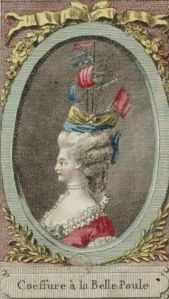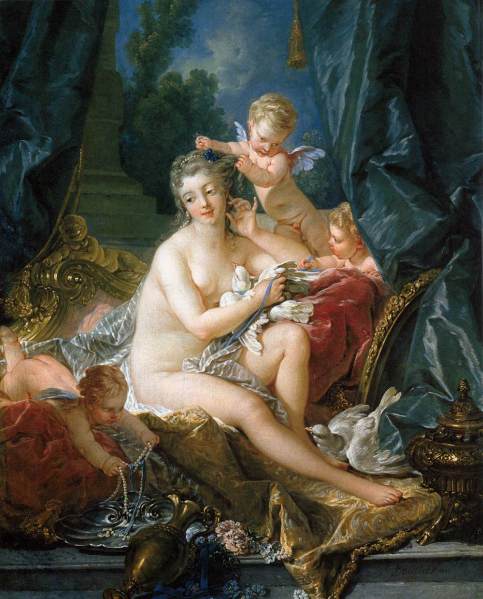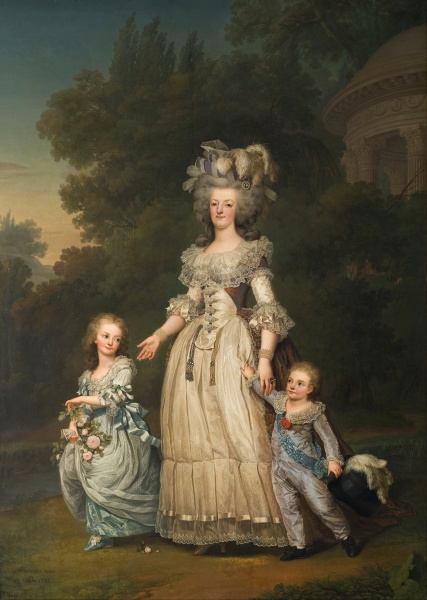or, Behind the Rococo Clock Face
 detail of Boucher’s 1756 portrait of Madame de Pompadour
detail of Boucher’s 1756 portrait of Madame de Pompadour
Among the learned books in Madame de Pompadour’s library, there was a unique volume about the rivers of France which had been written, and some of it printed, many years before by a diligent and inquisitive eight year old boy, based on his lessons in geography and typography.
Louis XV’s Cours des principaux fleuves et rivières de l’Europe (Courses of the Principal Rivers and Streams of Europe), written in 1718, which the adult man gave to his mistress as a token of the conscientious king that the playboy of Versailles had once wanted to be, survives in the Bibliothèque nationale.
The little print shop, which was built for Louis XV in the Tuileries nearly sixty-five years before Marie Antoinette’s fantasy-farm was installed at Le Petit Trianon, had a serious educative purpose to instill appreciation of crafts and machinery in a cultured king whose interests and personal accomplishments should reflect the nation’s glorious achievements.
Louis ‘the well-beloved’ grew up to enjoy his cultural responsibilities as king and patron of the arts and sciences. He enjoyed music, ballet and theatre; he supported scientific and botanical expeditions. He was fascinated by scientific invention and experiments, including some of the earliest in electricity. He collected timepieces, filling Versailles with all sorts of clocks and astronomical and navigational precision instruments.
Fashionable society followed his lead and the manufacture of technically advanced and high end luxury products in France boomed as a result. They included an exquisite and ingenious wind-up ring-watch, with a white face against a blue and gold background, set in diamonds, made in 1755 by Caron for Madame de Pompadour, which nowadays might operate as a cellphone and computer as well as tell the time, a smart-ring for people who have everything.
Stop the clock. The pendulum has swung so far to the right, that if one’s not careful, one might be seduced. This was the same middle-aged roué who neglected to reform the government and economy, whose foreign policy brought shameful defeat on the European battlefield, lost France her colonial empire, and nearly bankrupted the State, who died hated by the impoverished people for betraying them to famine and aristocratic oppression.
He died in agony, his once handsome face covered in black smallpox scabs, from a virulent strain of the disease which made his corpse decompose so quickly that it could not be embalmed, and its stench came through the coffin. This is the horror that always lay behind the pink and gold, the scalloped ormolu and arch pastoral, the self-mocking prettiness and smiling insouciance, the high comedy of Rococo.
It was the ancien régime’s stage-set breakwater against the tidal wave, which the king and Madame de Pompadour and anybody of sense knew was coming, at a time which no-one could rewind or stop.
 Astronomical clock designed by the engineer Passemant in Louis XV’s clock room at Versailles, presented to the king in 1750. Image: Wikipedia.
Astronomical clock designed by the engineer Passemant in Louis XV’s clock room at Versailles, presented to the king in 1750. Image: Wikipedia.
A king’s obsession with devices measuring time and space compensates for inability to rule his country; the ornate gilded decoration successfully disguises serious technological invention and precision.
His grandson, Louis XVI, had ten scientific laboratories at Versailles as well as his locksmith’s forge and carpentry workshop. He was like any other man in his home, doing DIY, relaxing by mending things, solving practical problems with his tools as therapy for being unable to control the vast, insoluble world outside his cave.
If Louis XVI had been politically adept, and time hadn’t run out for the Bourbon brand of absolutism founded by the terrifying despot Louis XIV, his wholesome hobbies would have endeared him to the people, instead of demonstrating how unfit he was to be king during economic austerity and social revolution.
Louis XVI had a library of 8000 books, so wins the Versailles bibliophiles’ contest for sheer quantity.
Madame de Pompadour enjoyed reading comedies and novels. She died in 1764, so the popular plays and the novel that define sex and power in 18th century French society most vividly for posterity were not in her collection. Les Liaisons Dangereuses, by Pierre Choderlos de Laclos, was published in 1782; Beaumarchais’ satirical comedy Le Barbier de Séville was first performed in 1775; the first public reading at Versailles of Le Mariage de Figaro was in 1781.
Her library included historical romances written by women. Much as she enjoyed a laugh, there is no record that she read vapid fantasies of sexual obsession and female degradation. She had quite enough trouble avoiding that at home with Louis XV.




 Adolf Ulrik Wertmüller, Marie Antoinette and her two eldest children walking in the park of Trianon (1785) oil on canvas, Nationalmuseum Sweden. Image source: Wikipedia.
Adolf Ulrik Wertmüller, Marie Antoinette and her two eldest children walking in the park of Trianon (1785) oil on canvas, Nationalmuseum Sweden. Image source: Wikipedia. Vigée-Lebrun, Self-portrait with her daughter Julie, c. 1789 oil on canvas Musée du Louvre, Paris. Image source: WGA.
Vigée-Lebrun, Self-portrait with her daughter Julie, c. 1789 oil on canvas Musée du Louvre, Paris. Image source: WGA.
 Guérin Georgiana, Duchess of Devonshire, with Lady Elizabeth Foster c. 1791
Guérin Georgiana, Duchess of Devonshire, with Lady Elizabeth Foster c. 1791







